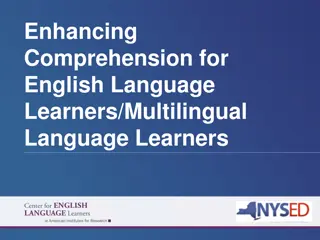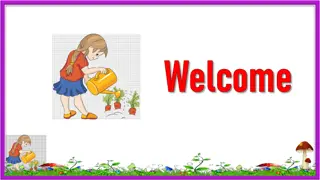Creative Lesson Starters for Engaging Learners
Explore innovative ways to kick off your lessons with these unique starter activities. From hiding words in pictures to brainstorming connections with strange images, these methods will captivate your students and promote interactive learning. Enhance vocabulary skills, critical thinking, and engagement with these dynamic lesson starters.
Download Presentation

Please find below an Image/Link to download the presentation.
The content on the website is provided AS IS for your information and personal use only. It may not be sold, licensed, or shared on other websites without obtaining consent from the author. Download presentation by click this link. If you encounter any issues during the download, it is possible that the publisher has removed the file from their server.
E N D
Presentation Transcript
FOLLOW THIS LINK TO CLICK & SPIN 3 TIMES Randomise Lesson Plan Generator Randomise Lesson Plan Generator
RED STARTER 1 Pictures hiding words hiding pictures:- With bits of paper or card or on a PowerPoint presentation, paste a selection of images of key words in text boxes. Cover those with the texts, characters, images or topics they refer to. Then cover those words with the same images again. As you go through, remove layers or set the slideshow to reveal them in sequence. By the time the images are shown for the second or possibly third time, learners will have associated them.
RED STARTER 2 Weird images:- On a poster, board or screen put up a display of a strange image. Learners have 5-10 minutes in silence to think of a way to relate it to the learning they have recently done. In that time, they need to find any vocabulary, equations, information or present any useful images and then explain their links.
RED STARTER 3 Grab the glossary:- One at a time, find a word from a textbook, dictionary, glossary or class notes and say it aloud. Then attempt to produce the correct spelling, a definition and an example of the word. Repeat or challenge a learning partner.
RED STARTER 4 Odd one out:- Use lists of words, sentences, spellings, equations, scientific rules etc. Add an extra, incorrect or unrelated example to the list and add it into an unknown section or scramble the list. Learners have to note which one in each list does not fit, explaining why.
RED STARTER 5 Synonyms and antonyms:- Create lists of opposite or contrasting rules, adjectives, effects or arguments presented side by side, but in a jumbled order on a board, sheet or table. Learners then have a brief time to do a timed written or physical re-arrangement and align the related opposites correctly.
RED STARTER 6 Backwords:- On a board, book or screen, show the final letter of a word, word of a sentence, number of a sum, portion of a diagram or image or stage of a sequence. Learners start at the end and attempt to find suitable options to put before it. Work backwards through the sequence to complete.
RED STARTER 7 Shape shifters:- Write or place a large collection of words, expressions, numbers, dates or names on a board, screen or sheet. Using any extra characters, words or symbols necessary, learners move up to three things around to leave an expression, phrase, rule or sum which makes sense. Then, learners or learning partners can add, remove or change one element and attempt to produce another meaningful expression.
RED STARTER 8 Word snakes:- Show a complete passage of text about the relevant topic on the board, including any dates, details, information, mathematical symbols, accents etc. Include no punctuation, capital letters or spaces between words. Learners have to re-structure the passage with all necessary spaces, capitals and punctuation, so that it makes sense and is grammatically accurate.
AMBER MAIN 1 Story time:- Learner is given an incomplete and cut up extract of a story, text, case study or write-up. They have to deduce, explain or guess what the continuation of the piece is.
AMBER MAIN 2 Exam skills:- Learners look at past papers or end of unit tests and find sections, topics, skills or vocabulary which could cause problems. They separate the elements or topics into bits they know immediately, bits they can work out or deduce and topics which might cause issues if there were an exam. Learner then eliminates large amounts of unnecessary extra learning, whilst refreshing their memories on it and additionally highlights where the targeted learning can focus.
AMBER MAIN 3 Liaison interpretation game:- Two or more learners could work on this. First person conveys a message relating to recent learning to the second, who interprets it into the original by writing or typing it down. If there is a third person, this can be repeated. Once the message has been conveyed to the partner or end of the line, all learners have to work out, organise or write the transcribed message and apply any corrections necessary.
AMBER MAIN 4 Debate:- Learner is given or produces opposing arguments or opinions to debate. They have to list points for both sides, discuss the argument, write up or act out their work as a mock debate. The debate proceeds in the point vs. counter point format.
AMBER MAIN 5 Running dictation:- Copies of an extended question and answer from an exam paper are printed out and positioned around the room or kept hidden on learning partner s computer. Learners are given 5 sets of 1 minute at a time to see or approach their text and memorise as much as possible. Then, after each of these minutes, they return and add what they can remember to a collective copy for 30 seconds, before returning to memorise for another minute. No relay of messages, speaking or copying of work from the text can take place. After 5 cycles of memorisation and writing have happened, the learners present their reproduced copy of the Q&A.
AMBER MAIN 6 Orienteering:- Several sequenced post-it notes of facts, figures, dates and details are placed around the learning area. Together with each one is a clue for locating the next clue. Learners have to find each clue, then compile their findings in exercise books or on paper.
AMBER MAIN 7 Wanted, dead or alive:- Learning partners produce a wanted poster or personal ad, acting as though they are a character from a text, an equation from a topic, a historical figure, a geographical feature, a specific element from the periodic table etc. Learners work with partners to practise their communication, description and presentation skills by asking about, collating and reproducing all the features they have worked out. Finally, learners produce a new poster or personal ad about the same subject and compare how closely they match the original.
AMBER MAIN 8 Dictee:- Learners listen to learning partner recite a verse, calculation, paragraph or speech. They have to copy what they hear as accurately as possible while they are listening. Once completed, they see the original on a screen, sheet or board and make corrections or additions to their work in another colour.
GREEN PLENARY 1 Self-speak:- Learner or learning partner records their voice reading facts, figures and information out. Learner then replays them and approve of or correct their own and their learning partner s words. Finally, learners re-record their voice, with corrected recital to help commit it to long-term memory.
GREEN PLENARY 2 No yes or no:- Learning partner asks questions about a topic, character or recent item of study. This can be as an interview, where learner takes on the role of the topic or character or as a hot-seat Q&A activity. Learners answer questions without saying yes or no.
GREEN PLENARY 3 Spelling bee:- Learner and learning partner take turns to announce key words from recent learning topics. They then take turns to attempt to spell them in a knock-out contest. Finally, learners compile lists of correctly-written words on revision cards.
GREEN PLENARY 4 Map store:- Learners make, print or project maps of a real or imagined country. In locations of map features, such as mountain ranges, counties, states, deserts etc, each topic studied is labelled. In each of these regions or features, one city is labelled as the capital. Each regional capital city becomes a store house for a particular set of words, which are listed in chunks under the city name. This helps memory via visualisation techniques.
GREEN PLENARY 5 Tick in the box:- In preparation for completing a reading, comprehension, new learning or listening exercise, learners prepare tick boxes with key words, facts, case studies or rules they might expect to learn about. As the activity progresses, learners keep the tick boxes in front of them for consultation. They tick all the words which they hear, learn, recognise or see and then keep the lists for future revision purposes. This keeps attention and subconscious memory active.
GREEN PLENARY 6 Fingers on the buzzers:- Learners are given some noise-making device (alarm, whistle, bell etc.) In the form of buzzer round questions, learners show their learning by responding to quick questions from the Acquire presentation, read by learning partners. If they are successful with one, they can take a turn at challenging learning partners.
GREEN PLENARY 7 Reading rewards:- To encourage reading and independent learning and revision, learning partners reward good work and engagement and stretch/ enrich quick learners by giving one piece of Faculty Room subscription Take-Away Learning stationery or merchandise to pupils at the end of activities.
GREEN PLENARY 7 Wishlist:- After completing a slice of Take-Away Learning, learners write a scrap of paper with 1 thing they have learnt, 1 way they can use it, 1 new active example and 1 way they think they can now add to, memorise or improve their learning. They write it on a post-it note or similar and stick it to a wall or highlight it in an exercise book, so that they can see progress and regularly refresh their memory of the learning in a snapshot.




































